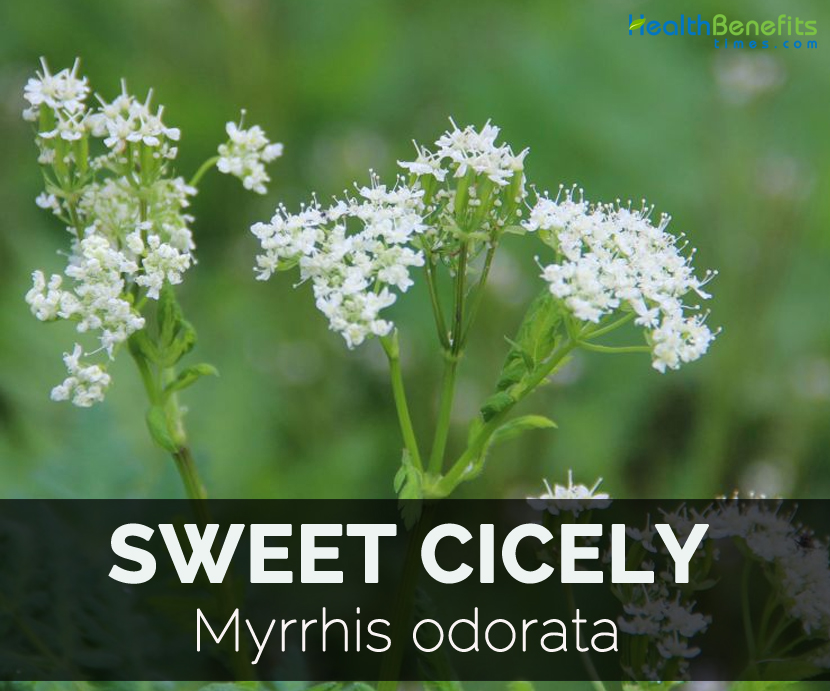| Sweet cicely Quick Facts | |
|---|---|
| Name: | Sweet cicely |
| Scientific Name: | Myrrhis odorata |
| Origin | The mountainous areas of Central and Southern Europe |
| Colors | Dark brown |
| Shapes | Linear-oblong; 15-25 mm long and 3-4 mm broad |
| Taste | Resembles aniseed |
Myrrhis is a monotypic genus, an herbaceous perennial native to mountainous regions of Central Europe having substantial taproots. Typically the bush grows to the height of 2 to 4 feet high and as wide with upright, grooved, hollow, upright and branching stems. The plant blooms flowers from May to June. Flowers are star shaped, white which fertilizes into ridge like fruits which are initially green and then becomes shiny and brown to black. The flowering stalks are hollow and reaches to the height of 1.8 meters, terminate in umbels of creamy to white flowers which forms distinctive, curved and brown fruits. Leaves are feathery and covered in soft hairs and have patches of silvery to white markings. It tolerates damp ground and light shade. It grows on verges and waysides. It has naturalized across Britain and is found in northern countries of England, Northern Ireland and Scotland. Sometimes, it is grown as a garden plant.
Cicely has soft and silky leaves which resemble the leaves of fern which are pale green and white on undersides. Leaves possess fragrance similar to anise herb. Stems are hollowed out internally having furrows on external surface. Root is thickened and large which grows deep into ground.
Leaves
Leaves are 2-4 times pinnate, lacy, finely divided, fern like and sparsely down on underside. Rachis and stalks of leaf have spreading whitish hairs. The sheath like stipule forms where leaf attaches to the stem. When crushed, leaves offer the smell of anise. Leaves measures 20 cm long.
Flower
An inflorescence is a compound umbel at the top of the stem and from upper leaf axils. It comprises of various umbellets and each umbellet has separate stalks that contain 8 or more small flowers. Each umbellet has several thin pointed green bracts. Flowers are five parted having white corollas with five spreading petals. There are five stamens having whitish filaments and white anthers that turn dark with pollen maturity.
Seed
Fruit have long, thin and brown ribbed seeds about an inch long that usually formed in pairs having strong anise flavor.
Habitat
Myrrhis odorata is endemic to mountains of Central and Southern Europe from Pyrennes to Caucasus. It is introduced and naturalized in cultivated areas, roadside verge, and grassland and river banks. It is ample in northern England and eastern Scotland.
Health Benefits of Sweet cicely
- Eases breathing
Sweet cicely helps to promote breathing. When consumed in form of tea, it alleviates breathing difficulties associated with bronchitis or asthma. The tea is useful for those with upper respiratory tract infections such as flu and common cold.
- Eliminate toxins
Sweet cicely has mild diuretic properties that make it an excellent blood purifier. Tea made from fresh leaves promotes production of urine and helps to eliminate toxins in the bloodstream. Due to its diuretic properties, it is effective in treating gout.
- Skin health
Sweet cicely has antimicrobial properties so the poultice or decoction is used to disinfect cuts and scrapes. It neutralizes bacteria in wounds.
- Relief from indigestion
Sweet cicely is used to ease indigestion. After the consumption of heavy meal or more spice or fat, the stomach becomes upset. Steep leaves in a cup of hot water and consume slowly to get better relief.
- Digestive health
Besides indigestion, tea made from fresh leaves is helpful to deal various health issues related to digestion. It is effective against stomach ulcers and associated symptoms.
- Treat animal bites
Sweet cicely is used to treat dog and snake bites. Sweet cicely acts as a first aid.
- Treat anemia
Sweet cicely helps to reverse anemia. Iron is a crucial mineral required for synthesis of oxygen carrying red blood cells. So one can improve the condition of anemia by consuming the foods rich in iron and making the dishes tastier with Sweet Cicely.
Culinary uses
- Leaves, seeds and roots are consumed raw or cooked.
- Leaves are dried for later use.
- Use the leaves to make tea.
- Add the chopped leaves to herbal butter, salads, soups, stews and omelets.
- Use it in soups and fish or chicken dishes.
- Add the fruits to salads or use it as a sweetener in ice cream, whipped cream and puddings.
- Add the seeds to baked foods such as cakes, cookies, fruit pies such as apple pies.
- Use the crisp stalks as the substitute for celery.
- Boil the roots.
Medicinal uses
- Use the plant to treat flatulence and coughs.
- Root decoction is used to treat dog bites and snake bites.
- Ointment made from roots helps to ease gout and also soothe wounds.
- Use it to treat asthma, cough and shortness of breath due to various lung problems.
- In folk medicine, crushed leaves are used as a cure for pain related with rheumatism and gout.
- To promote sleep, use the herbal tea made from leaves.
Precautions
- Consult the health practitioner for treating health ailments.
- Avoid its use if experienced any allergic reactions.
References:
https://www.itis.gov/servlet/SingleRpt/SingleRpt?search_topic=TSN&search_value=29768#null
https://pfaf.org/user/plant.aspx?LatinName=Myrrhis+odorata
https://www.sciencedirect.com/topics/agricultural-and-biological-sciences/cicely
https://crookedbearcreekorganicherbs.com/2018/03/04/spring-herb-cicely-myrrhis-odorata/
https://www.plant-world-seeds.com/store/view_seed_item/2322
https://www.friendsofthewildflowergarden.org/pages/plants/sweetcicely.html
https://www.britannica.com/plant/cicely-plant
https://www.seedaholic.com/sweet-cicely-myrrhis-odorata-organic.html
http://herbs-treatandtaste.blogspot.com/2010/11/sweet-cicely-herb-benefits-uses-and.html
http://medicinalherbinfo.org/000Herbs2016/1herbs/sweet-cicely/
http://www.foodreference.com/html/fcicelysweet.html
Comments
comments
